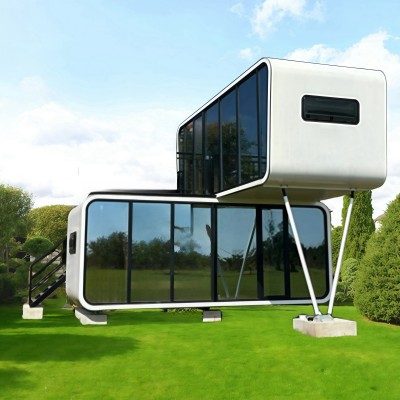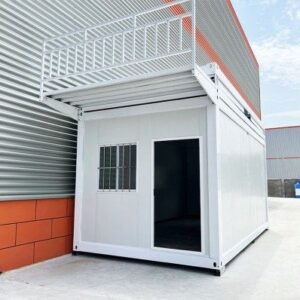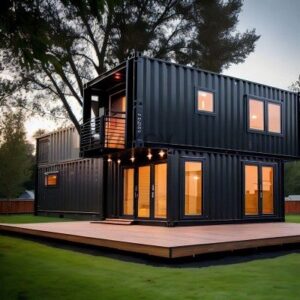Step by Step Construction How To Make Container House
Building a container house involves several clear steps, each one critical to creating a safe, comfortable, and durable home. Here’s what you can expect when going through the shipping container home construction phase.
Foundations and Site Preparation
Start by preparing a solid foundation that suits your site and container type. Common container home foundation options include:
- Concrete slab
- Pier and beam
- Strip footing
The foundation needs to be level and strong enough to support the weight of the containers. Proper site preparation means clearing debris, leveling the ground, and ensuring good drainage to avoid moisture issues.
Positioning and Securing Containers
Once your foundation is ready, place the containers on it exactly as per your layout. Use cranes or specialized equipment because containers are heavy and bulky. Securing containers involves:
- Anchoring containers to the foundation to withstand wind and seismic forces
- Aligning multiple containers precisely if building a multi-container home
Welding and Structural Integration
Modify and join containers through welding and reinforcing. This step keeps the structure stable:
- Cut openings for doors, windows, and interior access
- Reinforce cut areas with steel framing to maintain strength
- Weld containers together if stacking or side-by-side to ensure they behave like one structure
Interior Walls and Floor Installations
Next, install interior framing to divide rooms and support finishes. For floors:
- Add subfloor systems over the steel base of the container
- Use moisture barriers before laying flooring materials like hardwood, tile, or carpet
Interior walls can be built with standard drywall or plywood, depending on your insulation method and style.
Electrical Wiring and Plumbing Setup
Plan your electrical and plumbing systems carefully to fit within the container’s narrow walls:
- Run wiring through framed walls or beneath floors
- Install plumbing lines with access panels for future maintenance
- Use compact fixtures designed for small spaces to maximize room
Ensure all installations meet local building codes and pass inspections.
HVAC and Ventilation Considerations
Container homes can get hot or cold quickly, so HVAC and ventilation are essential:
- Install efficient heating and cooling systems suited for tight spaces, such as mini-splits or ductless systems
- Include proper ventilation to prevent moisture buildup and improve air quality
- Consider energy-efficient options to reduce costs over time
Roofing and Waterproofing
Finish with a durable roof and waterproofing measures to keep your container house dry:
- Add a sloped roof or green roof system to improve drainage and protect the metal containers
- Apply waterproof membranes or coatings on seams and joints
- Install gutters and downspouts to divert rainwater away from your foundation
Proper roofing prevents rust, leaks, and structural damage, ensuring your container home lasts for years.
What is a Container House Understanding Container Home Basics
A container house is a type of dwelling constructed using repurposed shipping containers. These steel boxes, originally built to transport goods worldwide, are transformed into functional living spaces by modifying their structure and interiors. Container houses are gaining popularity as a cost-effective, durable, and eco-friendly alternative to traditional housing.
Benefits of Container Houses
Building with shipping containers offers several clear advantages:Cost Efficiency
Shipping containers are often more affordable than traditional building materials, especially when using used containers. Construction is faster, reducing labor costs significantly.
Durability and Strength
Made from Corten steel, containers are designed to withstand harsh weather and heavy loads. This makes container homes extremely sturdy and long-lasting.
Eco Friendly
Repurposing containers reduces construction waste and the demand for new materials. Many builders incorporate energy-efficient insulation and solar panels to enhance sustainability.
Modular and Flexible Designs
Containers come in standard sizes like 20-foot and 40-foot lengths, making them easy to stack, combine, and customize to fit your needs.
Common Myths and Misconceptions About Container Houses
Despite their benefits, container homes face some misconceptions:
| Myth | Reality |
|---|---|
| Container houses are unsafe | Proper engineering and reinforcement ensure safety |
| They are too small to live in | Multiple containers and clever design maximize space |
| Poor insulation means cold | Effective insulation materials provide comfort year-round |
| Permits are hard to get | Many areas have clear permitting processes for container builds |
Understanding these facts helps clear doubts and highlights why container houses are a smart, modern housing solution.
For more detailed container house design ideas and construction steps, check out this guide on building a house using shipping containers.
Planning Your Container House
Assess Your Needs and Budget
Before diving into building a container house, clearly define your needs and budget. Think about how many rooms you require, your lifestyle, and future plans. Container homes vary widely in price depending on size, design complexity, and finishes. Set a realistic budget that covers:
- Container purchase or rental
- Site preparation and foundation
- Structural modifications like cutting and welding
- Insulation and interior work
- Utilities like plumbing and electrical
Knowing your budget upfront helps avoid overspending and guides your choices throughout the project.
Choosing the Right Type and Size of Containers
Shipping containers come mainly in two sizes: 20-foot and 40-foot lengths, with a standard width of 8 feet and height ranging from 8.5 to 9.5 feet (high cube). When selecting containers:
| Container Type | Length | Height | Common Use |
|---|---|---|---|
| Standard 20ft | 20 ft | 8.5 ft | Small homes, studios |
| Standard 40ft | 40 ft | 8.5 ft | Larger rooms, multi-container homes |
| High Cube 20/40ft | 20/40ft | 9.5 ft | Extra headroom, better airflow |
New containers cost more but offer better condition and longevity. Used containers save money but need thorough inspection for rust or damage. Consider your design needs and buyer sources carefully when choosing container types.
Site Selection and Foundation Considerations
The container house’s location heavily impacts construction and costs. Look for:
- Flat, stable land with good drainage
- Access for delivery trucks and construction equipment
- Permissions for container housing in the area
For foundations, typical options include:
- Concrete slab for stability and durability
- Pier or pile foundations for uneven or soft ground
- Gravel pads for smaller, lighter container homes
Foundation choice affects insulation and energy efficiency, so plan accordingly.
Designing the Layout Single vs Multiple Containers
Container home designs range from a single-container layout to combining multiple containers for larger spaces. Key points to consider:
- Single container homes fit minimal needs like tiny houses or studios and are easier to build.
- Multiple containers allow flexible layouts with separated rooms, decks, and unique shapes.
- Plan structural reinforcements if cutting walls between containers.
- Think about natural light, ventilation, and how spaces flow between containers.
Check out modular options like the 20-foot container tiny house for ideas on compact layouts.
Getting Permits and Legal Requirements
Securing permits and understanding local zoning laws is critical before construction. Regulations vary by state and county in the U.S., but generally cover:
- Building permits and inspections
- Zoning restrictions about container homes
- Utilities hook-up approvals
- Environmental impact considerations
Contact your local government office early to clarify container house permits and avoid costly delays. Often, working with professionals familiar with container home regulations speeds up approvals.
For detailed guidance, refer to building resources on how to build a house using shipping containers.
Preparing Shipping Containers for Construction
Before you start building your container house, preparing the shipping containers properly is crucial to ensure durability, safety, and comfort. Here’s what you need to focus on when converting shipping containers into livable spaces.
Inspecting and Cleaning Containers
Start with a thorough inspection of the container:
- Look for rust spots, dents, and any structural damage.
- Check for chemical or toxic residues from previous shipping loads—this is common in used containers.
- Clean the container inside and out using industrial cleaners or pressure washing to remove dirt, grease, and old paint that might be peeling.
Treat any rust you find with a rust converter or primer to stop further corrosion. This step protects the container’s steel walls and extends its life as a structure.
Structural Modifications
Once cleaned, you’ll need to make modifications to turn the container into a home:
- Cutting openings for doors and windows is essential for light and access. This requires professional tools and skills like plasma cutting or welding to avoid weakening the structure.
- Reinforce cut edges and corners with steel framing or welding to maintain container integrity. Containers are strong, but removing steel panels without support can cause structural problems.
Decide early if you’re using a single container or joining multiple containers since this affects structural work significantly.
Insulating the Container for Comfort
Shipping containers are made of steel, which makes them prone to extreme heat and cold without insulation. Choose insulation methods that work well with metal walls and fit your budget:
- Spray foam insulation: Best for sealing hard-to-reach spots and provides excellent thermal and moisture barriers.
- Rigid foam panels: Easy to install and moisture-resistant, suitable for walls and ceilings.
- Blanket insulation (fiberglass or mineral wool): More affordable, but needs proper vapor barriers to avoid condensation issues.
Proper insulation keeps your container home energy-efficient and comfortable year-round in most U.S. climates.
Installing Windows and Doors
Windows and doors aren’t just about appearance—they improve ventilation, light, and emergency access. When installing:
- Use cutouts made during structural modifications to fit standard window and door frames.
- Seal all edges properly with weatherproof caulk or flashing to prevent leaks.
- Consider double-glazed windows for better insulation and noise control.
Installing quality doors and windows increases your home’s security and value while making it livable and inviting.
Finishing Touches and Interior Design for Container Houses
Interior Finishes and Decorating Ideas for Container Homes
When finishing your container house, focus on materials that balance style, durability, and insulation. Popular choices include:
- Drywall or plywood for walls to create a homey feel
- Laminate or vinyl flooring that withstands moisture and is budget-friendly
- Bright paint colors or light wood paneling to open up small spaces
- Use multi-functional furniture like fold-out beds or storage ottomans to maximize usability.
Consider natural light—installing additional windows or skylights brightens the interior and reduces the need for artificial lighting.
Maximizing Space in Small Container Homes
Space can be tight in container homes, so smart design is key:
- Use vertical storage solutions like shelves mounted high on walls
- Opt for built-in furniture, such as benches with storage underneath
- Partition spaces with sliding doors or curtains instead of permanent walls
- Keep a clear, clutter-free floor plan for better flow
Energy Efficient Solutions for Container Houses
Efficiency is one of the best perks of container homes when done right. Simple energy upgrades to consider:
- LED lighting throughout to cut electric bills
- High-quality insulation to maintain temperatures and lower heating/cooling costs
- Energy-efficient windows and doors to prevent drafts
- Installing a programmable thermostat helps regulate HVAC use
Adding Eco-Friendly Features to Shipping Container Homes

Eco-friendly upgrades make container homes more sustainable and can reduce utility costs:
| Feature | Benefits | Notes |
|---|---|---|
| Solar panels | Renewable energy, lower utility bills | Can be scaled based on energy need |
| Rainwater systems | Water savings, irrigation or gray water use | Requires proper filtration & storage |
| Green roofing | Improves insulation, reduces runoff | Adds biodiversity and cooling |
| Energy-efficient appliances | Lowers electricity consumption | Look for ENERGY STAR certified options |
These features not only boost your container home’s eco-credentials but also appeal to local incentives and rebates often available in many U.S. states.
Cost Breakdown and Budget Tips for Building a Container House
Building a container house is a smart and affordable way to get a unique home, but understanding the average costs and where to allocate your budget is key. Knowing where to save and where to invest will help you avoid surprises and get the best value for your money.
Average Cost to Build a Container House
The cost of building a container house varies based on size, location, and finishes. Here’s a rough breakdown for a U.S. market homeowner:
| Cost Item | Estimated Price Range |
|---|---|
| Used Shipping Containers | $3,000 – $6,000 per 20-foot |
| New Shipping Containers | $5,000 – $8,000 per 20-foot |
| Site Work and Foundation | $5,000 – $15,000 |
| Structural Modifications | $10,000 – $20,000 |
| Insulation | $3,000 – $8,000 |
| Windows and Doors | $3,000 – $10,000 |
| Electrical/Plumbing/HVAC | $10,000 – $25,000 |
| Interior Finishes | $8,000 – $20,000 |
| Permits and Legal Fees | $1,000 – $5,000 |
| Contingency and Miscellaneous | 10% – 15% of total costs |
Typically, a 500 to 1,000 square foot container home can cost between $45,000 and $120,000, depending heavily on design complexity and finish quality.
Where to Save and Where to Invest
When budgeting your container house construction, consider these tips:
Save On
- Used Containers: Buying used units can cut initial costs drastically but inspect carefully to avoid damage.
- DIY Work: If you have basic construction skills, handling interior finishes or painting yourself can save labor.
- Simple Design: Avoid complicated container stacking or unusual layouts to reduce structural and welding costs.
Invest In
- Insulation and HVAC: Quality insulation and ventilation systems prevent costly temperature and moisture problems.
- Foundation and Site Prep: A solid foundation ensures long-term structural integrity; skimping here is risky.
- Permits and Legal Compliance: Proper permits avoid legal headaches, fines, or costly rework.
- Waterproofing and Roofing: Containers prone to leaks—proper roofing protects your investment.
Financing Options and Incentives
Financing a container home may differ from traditional home loans, but here are some options:
- Personal Loans or Home Improvement Loans: Useful for those building on property they already own.
- Construction Loans: Offered by some lenders familiar with modular and container homes.
- FHA and VA Loans: These may be available if your container house meets certain codes and standards.
- Green Building Incentives: Some states and local governments offer tax credits or rebates for eco-friendly builds, like solar panel installation or rainwater harvesting systems.
Before starting, check local incentives and financing opportunities. You can also explore ready-made solutions like luxury container houses or prefabricated container houses that help control cost and complexity.
Budget smart by aligning your container home vision with careful spending and local financial options.
Common Challenges When Building a Container House and Expert Tips
Building a container house comes with some unique challenges compared to traditional homes. Knowing what to expect and how to address these issues can save time, cost, and frustration during your container home construction.
Dealing with Structural Limitations in Container Home Construction
Shipping containers are designed to be strong but only support heavy loads on their corners and edges. This affects how you can modify and expand them:
- Cutting large openings for windows and doors weakens the container’s structure. Always reinforce cut areas with steel framing or supports.
- Stacking multiple containers requires careful planning for load distribution and welding to ensure stability.
- Keep in mind that containers have limited ceiling height, which might require raising or modifying roofs for comfort.
- Use experienced structural engineers or architects familiar with container home design to avoid costly mistakes.
Overcoming Insulation and Condensation Issues
Insulation is possibly the biggest technical hurdle in container house building, since steel conducts heat and cold easily:
- Choose the right insulation method: spray foam insulation is popular for sealing gaps and moisture control, but rigid foam panels and blanket insulation work well too.
- Proper ventilation and vapor barriers are critical to prevent condensation buildup inside walls, which can cause rust and mold.
- Consider adding thermal breaks, such as wood or vinyl framing to separate the steel from interior walls.
- Installing energy-efficient windows and doors reduces heat loss and moisture issues.
Hiring Professionals vs Doing It Yourself
Many people consider a DIY container home to save money, but it depends on your experience and project complexity:
When to hire pros:
- If you’re unfamiliar with welding, structural reinforcement, insulation techniques, electrical wiring, or plumbing, experts help prevent safety hazards and code violations.
- Navigating permits, zoning, and building inspections can be tricky for a first-timer.
- Professionals speed up construction and reduce unexpected costs.
When DIY works:
- If you have solid construction skills and time to learn, DIY can cut labor costs.
- Simple container conversions or small builds may be manageable on your own.
- Make sure to educate yourself through reliable DIY container home plans and tutorials.
Resources for Further Learning on Container Home Construction
To build the best container house possible, keep learning from experienced sources:
- Online forums and groups like Shipping Container Home Builders USA provide community support and advice.
- Websites and blogs focused on container home design ideas and modular container home building tips offer tutorials and inspiration.
- Books and courses on building with shipping containers cover everything from foundation options to energy efficiency.
- Consult local building departments early to understand your area’s container house permits and legal requirements.
By understanding these common challenges and applying expert tips, your container house project will be smoother, safer, and ultimately more enjoyable.
Inspiring Container House Examples and Success Stories
Looking for real-world container house design ideas? Let me share some inspiring examples and testimonials that show what’s possible with shipping container home construction.
Yichen Example Projects
Yichen, a well-known name in modular container home building, has completed numerous projects across the U.S. Their work highlights how versatile and stylish container homes can be:
- Modern Urban Living: Yichen’s container homes in city settings combine sleek, industrial aesthetics with smart layouts, fitting perfectly into tight urban lots.
- Eco-Friendly Designs: Many projects feature solar panels, rainwater systems, and green roofs that maximize energy efficiency.
- Custom Modular Builds: Yichen uses multiple containers to create spacious, modular homes that adapt to family needs, proving a container house doesn’t mean sacrificing comfort.
These projects demonstrate how professional planning and design can overcome common doubts about container homes.
Customer Testimonials
Hearing from those who built or live in container houses gives real insight into the process and benefits:
- Cost Savings: Many owners appreciate saving 30-50% compared to traditional homebuilding costs.
- Quick Construction: Customers praise how container homes can be set up much faster than stick-built houses, sometimes within a few months.
- Durability and Security: Homeowners note sturdy construction and good protection against extreme weather.
- Creative Freedom: Users love the flexibility of modifying container layouts with windows, doors, and insulation tailored to their lifestyle.
Some typical remarks include:
- “Building with shipping containers allowed us to stay within budget and create a unique, modern home that’s eco-friendly.”
- “We chose a modular container home design so our house could grow with us, adding more space as needed.”
- “The toughest part was understanding permits and legal requirements, but once that was cleared, the build moved fast and smooth.”
Why These Examples Matter
container house projects like Yichen’s and customer experiences highlight:
- The practicality of shipping container home construction for U.S. buyers
- How to balance durability, comfort, and eco-friendliness
- How to tackle common challenges like insulation and legal clearances effectively
Real examples and success stories add credibility and inspiration, showing that container homes are a serious, smart alternative to traditional housing



